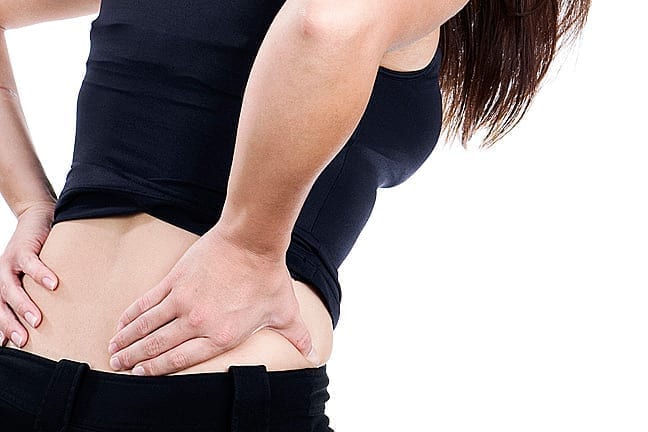In order to stand up straight and walk upright, our lower back handles pressure and shock absorption. We’re not complaining about walking, so we have to train our lower backs to support the rest of our bodies.There are numerous risk factors related to back pain. These include smoking, your age, your job and certain diseases, like arthritis. The two biggest factors are omental obesity (excessive fat around your abdominal tissues and organs) and core muscle weakness.With obesity, it makes some anatomical sense: The bigger your belly, the more likely it is that your center of gravity is pulled forward. This puts strain on the back. If you drop weight you may be able to ease the tension.You can still have back problems if you’re very skinny. Weak core muscles are probably to blame. This area includes your hips, lower back and abdominals. That core tissue acts as a back brace. It’s made of muscles, tendons and ligaments.If your anatomical back brace is tight, you’ll absorb shock and provide a strong foundation for the movement you do throughout the day. But if your brace is loose and weak, this could result in severe pain (when you do something as simple as handing your kid a bottle from the front seat).Your back is made of an intricate system of nerves, bones and tissues. Here are the main ones to know about.QUIZ: Body HealthVertebrae and DiscsYour spine is made of small, stacked bones that form a column separated by discs. You could think of the spine as a column of doughnuts, separated by wedges of cheese.The doughnut portion would be the vertebrae. The spinal cord travels inside the holes. The cheese wedges are the discs. When you put too much weight and twist on the spine, the disc of cheese squishes out. This is called a bulging disc, which pushes against and compresses either the spinal cord or the nerve root on either side.The oozing discs can leak irritating chemicals, which cause inflammation and great pain. Diluting or washing away these chemicals (with liquid injections like steroids) seems to relieve pain successfully.The curvature of your spine is for shock absorption. If the spine were straight, the impact would all be passed directly from our feet to our head. We are able to have a narrow, fast gait because we walk with our legs, not our spine.MusclesSurrounding your spine, there’s a large, complex set of muscles that act as your anatomical administrative assistant—they provide support. These muscles are broken into three broad categories. Extensors, which are attached to the back of the spine, give you strength to stand. Flexors are in the front of the spine and help you bend forward. Lastly, obliques are attached to the sides and help you twist from side to side. The abdominal muscles are the most important front muscles of the lower back.When you injure your back, it’s also the collateral damage that causes problems, not just the injury itself. This includes straining your other muscles to make up for your bad back. You can also develop inflammation around the nerves. This is why anti-inflammatory medicines (ibuprofen and naproxyn) help. So do rehab and take fish oil (or the DHA equivalent), or your doctor may prescribe steroid shots.MORE: How To Get Your Omega-3s (Not All From Fish!)When you have a bad back, it’s a dangerous domino effect. You can’t exercise or have sex, which then makes you depressed. It may hurt to even cough or go to the bathroom. This starts a downward spiral if you don’t take care of it.You’d think that most people prone to back pain would be contact sport athletes or contortionists. It’s much more common, though, to suffer from back pain because of sitting! Sitting in a fixed, slumped position actually cases much strain on your back. Yes, this is one reason why it’s necessary to maintain good posture (aside from looking confident and more attractive).Sitting increases pressure in the discs more than standing. It also leaves the back muscles weak. Sitters develop disuse atrophy (if you don’t engage the muscles, you lose ‘em). Poor posture also puts your back at risk. Belly muscles are lax so your spine bears the brunt of any awkward movements.Nerves and myelinNerves exit the spine through a small space called a foramen. Sometimes nerves get trapped in this small space as they exit the spine. They can also be inflamed by recent trauma, or surrounded by fat.This delicate myelin sheath that coats our nerves to prevent short-circuiting is compressed with resulting inflammation. Since the nerve that comes out from that area of the back powers the muscles of the foot and lower leg, you usually feel low-back nerve compression and inflammation in the leg.This is accompanied by shooting paints down the leg, or dull aching pain in the back or buttocks.Like many other parts of our body, nerves simply get inflamed and have less room to move as fat fills the space. As we age, nerves lose insulation like an old copper wire. By contrast, muscle spasm is the sustained contraction of a muscle supplied by an inflamed nerve, which may fire repeatedly.The contraction results in a weakened muscle and pain without new oxygen. This sequence of contraction without more oxygen repeats itself. If you can’t break the cycle, it will get worse.The solution to both problems is to rebuild the insulation and/or restore normalcy with nutritional support (and some time) so the inflammation can resolve. If your core muscles are strong, you have less chance of muscle spasm and nerve trauma from disc injury.
© YouBeauty 2024




































